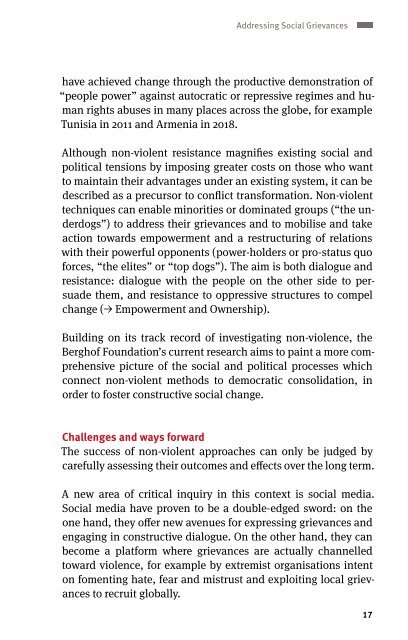Berghof Glossary on Conflict Transformation
The Berghof Glossary on Conflict Transformation presents 20 of the main principles and approaches used by the Berghof Foundation in its work. It is a concise and accessible exploration of what it takes to create “space for conflict transformation”. 2019 edition.
The Berghof Glossary on Conflict Transformation presents 20 of the main principles and approaches used by the Berghof Foundation in its work. It is a concise and accessible exploration of what it takes to create “space for conflict transformation”. 2019 edition.
You also want an ePaper? Increase the reach of your titles
YUMPU automatically turns print PDFs into web optimized ePapers that Google loves.
Addressing Social Grievances<br />
have achieved change through the productive dem<strong>on</strong>strati<strong>on</strong> of<br />
“people power” against autocratic or repressive regimes and human<br />
rights abuses in many places across the globe, for example<br />
Tunisia in 2011 and Armenia in 2018.<br />
Although n<strong>on</strong>-violent resistance magnifies existing social and<br />
political tensi<strong>on</strong>s by imposing greater costs <strong>on</strong> those who want<br />
to maintain their advantages under an existing system, it can be<br />
described as a precursor to c<strong>on</strong>flict transformati<strong>on</strong>. N<strong>on</strong>-violent<br />
techniques can enable minorities or dominated groups (“the underdogs”)<br />
to address their grievances and to mobilise and take<br />
acti<strong>on</strong> towards empowerment and a restructuring of relati<strong>on</strong>s<br />
with their powerful opp<strong>on</strong>ents (power-holders or pro-status quo<br />
forces, “the elites” or “top dogs”). The aim is both dialogue and<br />
resistance: dialogue with the people <strong>on</strong> the other side to persuade<br />
them, and resistance to oppressive structures to compel<br />
change (→ Empowerment and Ownership).<br />
Building <strong>on</strong> its track record of investigating n<strong>on</strong>-violence, the<br />
<str<strong>on</strong>g>Berghof</str<strong>on</strong>g> Foundati<strong>on</strong>’s current research aims to paint a more comprehensive<br />
picture of the social and political processes which<br />
c<strong>on</strong>nect n<strong>on</strong>-violent methods to democratic c<strong>on</strong>solidati<strong>on</strong>, in<br />
order to foster c<strong>on</strong>structive social change.<br />
Challenges and ways forward<br />
The success of n<strong>on</strong>-violent approaches can <strong>on</strong>ly be judged by<br />
carefully assessing their outcomes and effects over the l<strong>on</strong>g term.<br />
A new area of critical inquiry in this c<strong>on</strong>text is social media.<br />
Social media have proven to be a double-edged sword: <strong>on</strong> the<br />
<strong>on</strong>e hand, they offer new avenues for expressing grievances and<br />
engaging in c<strong>on</strong>structive dialogue. On the other hand, they can<br />
become a platform where grievances are actually channelled<br />
toward violence, for example by extremist organisati<strong>on</strong>s intent<br />
<strong>on</strong> fomenting hate, fear and mistrust and exploiting local grievances<br />
to recruit globally.<br />
17










